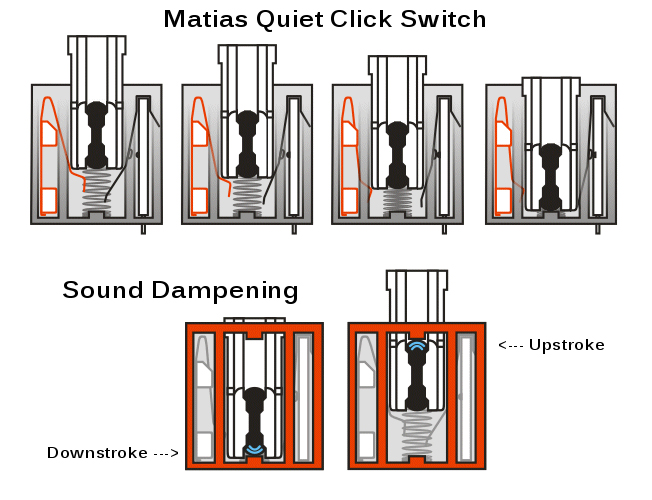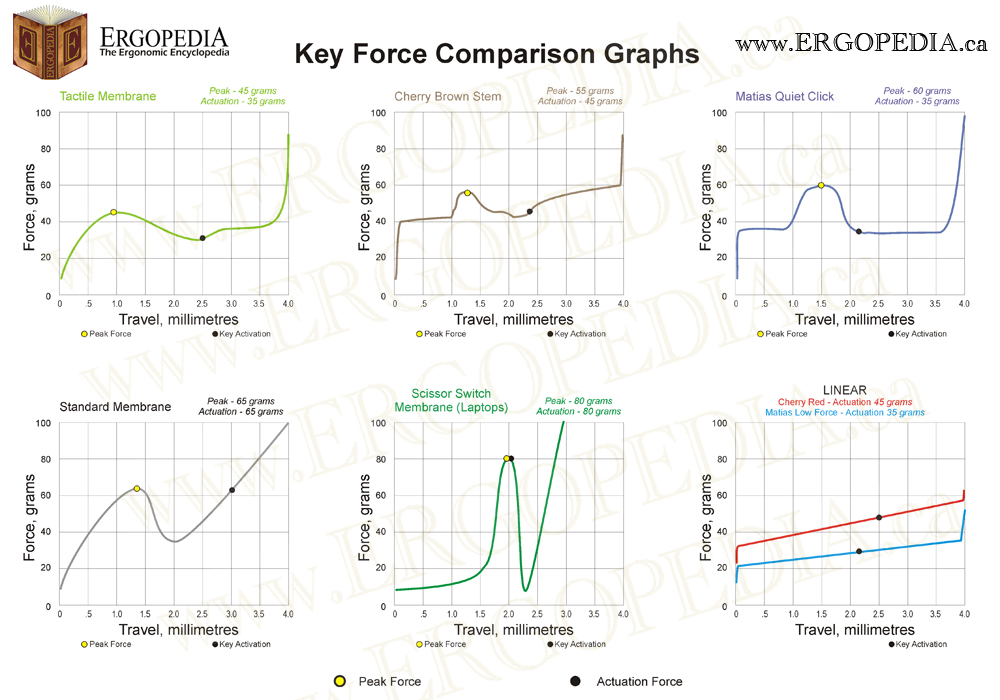One of our favorite resources about ergonomics is "Ergopedia". This is an independent site that has in-depth discussion and analysis about a large variety of ergonomics topics. The article below discusses various brands of mechanical keyboards and how they compare on the topic of "tactility". The source of the article is:
http://www.ergopedia.ca/ergonomic_concepts/Tactility_on_Keyboards_How_to_Evaluate_Soft_or_Light_Touch.html
Tactility on Keyboards - How to Evaluate "Soft" or "Light" Touch
What is Tactility?
Tactility in reference to keyboards refers to feedback that a user receives when typing, specifically associated with the position along the key travel when a keystroke is generated. This feedback can come in several forms; Audible (i.e. a click sound), Tactile / Haptic (i.e. a perceptible increase in resistance during key travel) and Visual (seeing the fingers depress the key and spring back up with the keycap). For most individuals, the most important feedback is Tactile / Haptic as it is the same sense as that which works with muscle movement in the fingers (eyes and ears are more removed from the process of pressing a key).What is makes a keyboard 'light' or 'soft' touch?
The concept of "light" or "soft" touch is a common and desirable attribute sought by both users and ergonomic professionals. However, this can mean different things to different people. For some it might mean the lowest total Work (Force times Distance in a Physics sense) required, which would make a higher actuation force for lower travel distance mechanism such as the scissor-switch membrane "lighter". For others it may refer solely to actuation force which would make zero-force touch-surface interfaces such as smart phones or tablets "lighter". However, studies have shown that tactility is the most significant factor in yielding a sensation of "light" or "soft" touch as tactility directly affects the amount of force used by an individual when generating a keystroke.
The actual rating on the force used to actuate a key (i.e. generate a keystroke) is not the only factor in determining the amount of force actually used by a user. The reality is that most people will press keys harder than they need to unless they are given an indication that the key has fired i.e. a tactile sensation where one can feel when the keystroke is actuated. Many membrane keyboards offer little to no tactility as the key must be pressed all the way down to actuate, and few can accurately generate the amount of force and distance needed when the only indication of this is when the keycap "bottoms out" at the end of the keystroke. This is an even greater problem with scissor-switch membranes (commonly used on laptops) due to the reduced key travel distance, although because of the reduced distance there is a perception of less force. All mechanical keyswitches (except for linear keyswitches) provide a tactile indicator when the key fires and post-actuation braking key travel prior to bottoming out. This provides a clear indication of the amount of force required to actuate the key and also a "deceleration ramp" of sorts for your finger, preventing you from the jarring impact of reaching the end of the key travel distance. The Cherry Red Switches are linear (no bump) whereas the Cherry Brown Switches are tactile (the bump provides the increased force and tactility).

The Matias Quiet Click Leaf Keyswitch pictured at right provides far more capacity for control of the force curve. Cherry key switches can only create variance in force by adjusting the sculpting of the plastic that the metal bump slides against. The leaf allows not only angle, but thickness of the metal and associated degree of resistance to flexion. Because nothing “snaps” you don’t get the same audibility of click that you do on Brown Cherry keyswitches, or blue ones (where the sections of the key stem snap together during movement to generate audibility). The dampening material on both ends of the stem prevent noise on the down stroke (like an o-ring) and on the up stroke. The Low Force Quiet Click Linear Leaf Keyswitch has a linear force curve with static slope throughout the entire key travel distance and offers no tactility (a bump where the slope increases), but is lower throughout the curve when compared to the Cherry.
The graphs below provide a clear indication of the force dynamics of different types of keyswitches. The yellow dot indicates the peak force, or the highest resistance point as the key moves through the full key travel distance. The black dot indicates the point along key travel when the keystroke is actuated. The ideal attributes for a force curve should provide an increase in resistance (i.e. tactile indicator) PRIOR to the activation point (the black dot) without significantly increasing the peak force required to actuate the key. Following actuation, the resistance should increase gradually (i.e. further tactile feedback) as opposed to declining after activation. There must also be significant key travel distance after activation to provide the opportunity for the user to stop pressing down and avoid "bottoming out". As keyswitches move to overall lower force, they increasingly fail to be able to provide tactility as there can be no significant differential between the peak and the trough on the graph.

A tactile membrane dome keyboard (upper left) offers a very similar force curve to a tactile mechanical switch (upper middle and right). The primary difference is superior tactile demarcation of the peak force and a more optimal force curve following actuation (Matias offers a higher differential and as such clearer tactility). On the LINEAR keyswitches (bottom right), there is no tactility (and why you see a straight line).
On the standard membrane (bottom left) the actuation point is too far into the key travel distance, coming after a significant increase in force. A user would interpret this as signaling them to stop pressing down (as presumably the keystroke has been generated) when in fact it has not. After noticing repeated keystrokes which fail to register, the user would increase their force and perceived travel distance to ensure that the key is guaranteed to actuate. On scissor switch membrane keyboards (bottom middle) the user experiences tremendous increase in force immediately after actuation, which makes it impossible to prevent the “bottoming out” at the end of a keystroke. There have been studies which show that while a lower actuation force reduces the amount of force exerted when striking a key, a longer key travel distance reduces the amount force exerted significantly more.
CRITICAL CONCEPT – TACTILITY IN CONJUNCTION WITH SUFFICIENT KEY TRAVEL ACTIVELY OPTIMIZES TYPING FORCE
In the absence of tactility... the only indicator is the amount of resistance which is perceived by the user as they press a key. Individuals cannot "choose" to use 80 grams of force exactly without some kind of feedback; studies have shown that the force will be anywhere from 10% to 100% higher (usually around 40-60%).
In the absence of sufficient key travel... there is no forgiveness on the part of the mechanism, and the joints in the fingers have to absorb all the shock of bottoming out with every keystroke generated. As you add key travel after actuation, the user has a steadily increasing opportunity to "pull up" and stop pressing the key down and avoid bottoming out.